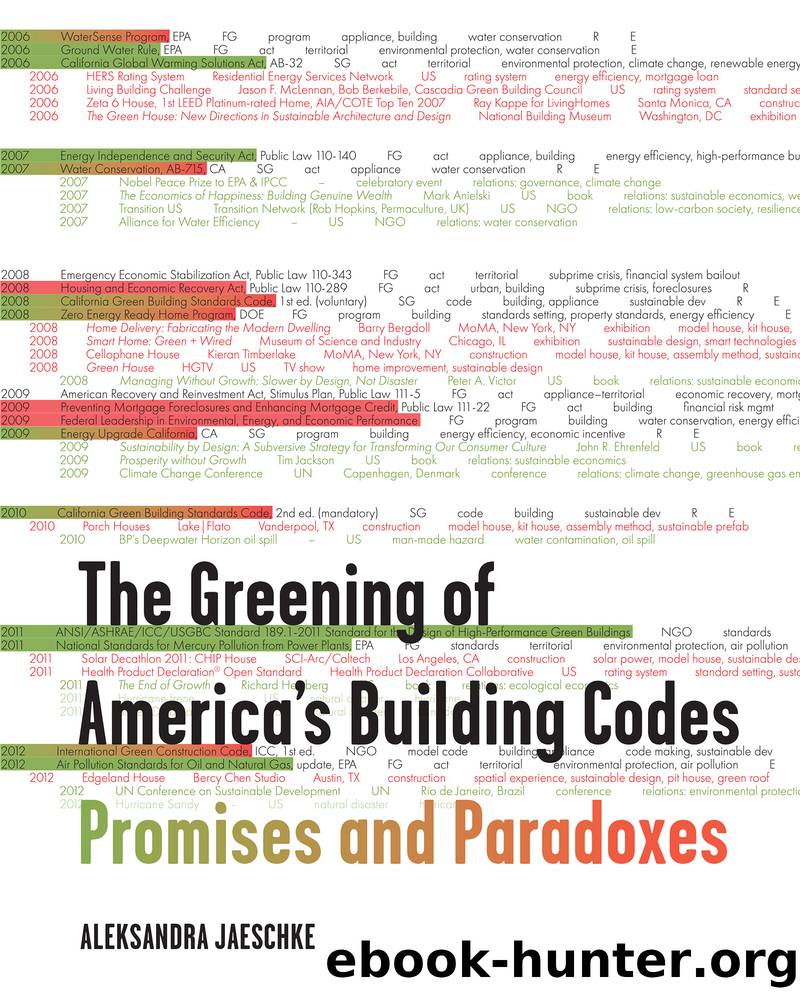The Greening of America's Building Codes by Aleksandra Jaeschke

Author:Aleksandra Jaeschke
Language: eng
Format: epub
Publisher: Princeton Architectural Press
5.3. Why Continue Stacking? Focus: Air
Air is another matrix, just more intangible and hence less controllable than water. While we do not respect watershed boundaries, the wind does not respect ours, carrying pollutants across borders.62 Similar to indoor air, ambient (or outdoor) air quality was initially the responsibility of individual states. Although California passed the nationâs first air-pollution act in 1947, in response to smog, the importance of air quality for public health was not acknowledged until the passage of the first federal Air Pollution Act in 1955 and fully recognized in the Clean Air Act (CAA) of 1963 and subsequent amendments.63 In response to the CAA standards for automobiles, and the more stringent state Zero Emission Vehicle program, the building code, specifically its CALGreen portion, includes provisions that indirectly address ambient air quality by imposing mandatory and voluntary measures to âfacilitate future installation and use of EV chargersâ in new residential buildings and by promoting the use of bicycles.64
Unable to control local land use since it is controlled by municipalities, the building code (enacted by the state) can only regulate construction practices. It cannot, as an example, stop the City of Los Angeles from approving residential developments within one thousand feet of a freewayâa fact so commonly recognized as an extreme health hazard that the municipality releases an advisory notice together with building permits.65 The structure of the CALGreen Code, nonetheless, suggests that this might change in the future. While land-use practices are included among voluntary measures in the form of recommendations and the section entitled âOutdoor Air Qualityâ is a âreservedâ placeholder, we know from previous editions that what is now voluntary is meant to become mandatory in the future, and what is reserved will one day contain new provisions.66
Indoor Air
While of relatively little influence on ambient air, the CALGreen Code and other parts of the California Building Standards Code are extensively used to regulate air quality indoors, which remains outside the jurisdiction of the federal government.67 After all, ventilation has been one of the initial objects of code makersâ attention, and the current Residential Code (Section 1.1.2, âPurposeâ) continues to list it as one of the fundamental aspects of public health and welfare.68 Yet while ventilation has been regulated for more than a century, indoor air quality emerged as a side effect of the post-oil-crisis wave of weatherization, which made buildings warmer but also overly airtight.69 Ironically, while Ulrich Beck was warning that âprivileged ways of living may still provide a refuge from air and noise pollution, but the waters will soon be polluted everywhere, and we will be equal before more than just the bomb,â researchers were proving that there was nowhere to escape from the volatile effects of industrialization.70 Homes, too, were poisoned. Indoor contaminants, such as volatile organic compounds (VOCs), were everywhereânot just in cleaning products handled by domestic workers, but in carpets, sofas, and wallpapers, the very embodiments of home comfort. While the buildings were too airtight to remove these indoor pollutants, they
Download
This site does not store any files on its server. We only index and link to content provided by other sites. Please contact the content providers to delete copyright contents if any and email us, we'll remove relevant links or contents immediately.
Whiskies Galore by Ian Buxton(41879)
Introduction to Aircraft Design (Cambridge Aerospace Series) by John P. Fielding(33064)
Small Unmanned Fixed-wing Aircraft Design by Andrew J. Keane Andras Sobester James P. Scanlan & András Sóbester & James P. Scanlan(32743)
Craft Beer for the Homebrewer by Michael Agnew(18140)
Turbulence by E. J. Noyes(7936)
The Complete Stick Figure Physics Tutorials by Allen Sarah(7307)
Kaplan MCAT General Chemistry Review by Kaplan(6867)
The Thirst by Nesbo Jo(6828)
Bad Blood by John Carreyrou(6552)
Modelling of Convective Heat and Mass Transfer in Rotating Flows by Igor V. Shevchuk(6391)
Learning SQL by Alan Beaulieu(6211)
Weapons of Math Destruction by Cathy O'Neil(6146)
Man-made Catastrophes and Risk Information Concealment by Dmitry Chernov & Didier Sornette(5921)
Digital Minimalism by Cal Newport;(5664)
Life 3.0: Being Human in the Age of Artificial Intelligence by Tegmark Max(5474)
iGen by Jean M. Twenge(5366)
Secrets of Antigravity Propulsion: Tesla, UFOs, and Classified Aerospace Technology by Ph.D. Paul A. Laviolette(5309)
Design of Trajectory Optimization Approach for Space Maneuver Vehicle Skip Entry Problems by Runqi Chai & Al Savvaris & Antonios Tsourdos & Senchun Chai(5011)
Pale Blue Dot by Carl Sagan(4912)
